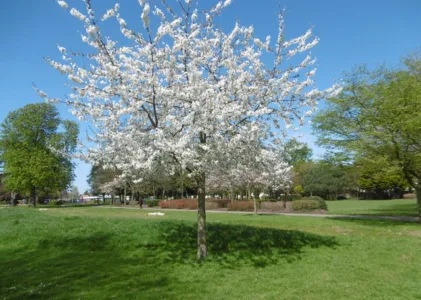Serviceberry Tree: Growing Tips, Caring, Recipes, and More: Are you looking for a unique and beautiful tree to add to your garden or landscape? Consider the Serviceberry tree, also known as Juneberry, Shadbush, or Saskatoon. This native North American tree has a long and fascinating history, as well as numerous benefits for gardeners and homeowners.
Table of Contents
What is a Serviceberry Tree?
The Serviceberry tree is a deciduous tree that can grow up to 20-25 feet tall. It belongs to the Rosaceae family, which also includes roses, apples, and pears. In the spring, the tree produces beautiful white flowers, which are followed by small red, purple, or black fruit in the summer.
The Serviceberry tree has been an important part of North American ecosystems for thousands of years. Native American tribes used the tree’s fruit for food, medicine, and ceremonial purposes. The berries were often dried and stored for winter use, or used fresh in soups, stews, and pemmican.
The Serviceberry tree was also an important symbol in many Native American cultures. Some tribes believed that the tree had the power to protect against evil spirits, while others used it as a symbol of renewal and springtime.
European settlers in North America also recognized the many benefits of the Serviceberry tree. Early pioneers used the fruit as a substitute for raisins, and the tree’s hard wood was used for tool handles and other implements.
Today, the Serviceberry tree continues to be a popular choice for gardeners and landscapers. Its beautiful flowers and delicious fruit make it a valuable addition to any landscape, while its health benefits make it a popular ingredient in natural remedies and dietary supplements.
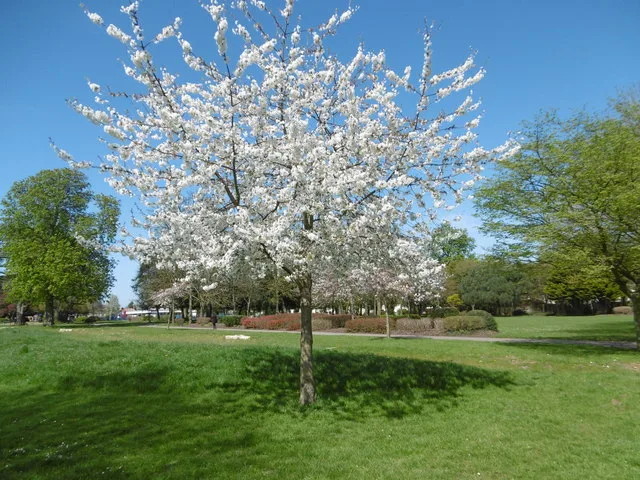
Serviceberry tree: key facts
- Height: Serviceberry trees can range from 6 to 25 feet in height, depending on the species and variety.
- Sun: Serviceberry trees prefer full sun to partial shade, although some varieties can tolerate shade.
- Hardiness zone: Serviceberry trees are hardy in zones 3 to 9, depending on the species and variety.
- Flowering season: Serviceberry trees typically bloom in early spring, producing white or pink flowers before the leaves emerge.
- Flower size: The flowers of Serviceberry trees are small, typically less than an inch in diameter.
- Leaves: Serviceberry trees have simple, alternate leaves that are usually oval or oblong in shape, with serrated edges. The leaves can range from 1 to 4 inches in length, depending on the species and variety. In the fall, the leaves turn shades of yellow, orange, and red.
- Fruit: Serviceberry trees produce small, edible berries that are usually dark purple or black when ripe. The berries are typically around 1/2 inch in diameter and have a sweet flavor.
- Wildlife: Serviceberry trees are popular with wildlife, including birds, squirrels, and deer, who enjoy eating the fruit.
- Uses: In addition to their ornamental value, Serviceberry trees have a number of practical uses. The fruit can be eaten fresh or used in a variety of recipes, including pies, jams, and syrups. The wood is also prized for its hardness and durability, and is used for making tool handles, furniture, and other objects.
- Cultivars: There are many different cultivars of Serviceberry trees, each with its own unique characteristics. Some of the most popular cultivars include ‘Autumn Brilliance’, ‘Regent’, and ‘Thiessen’.
- Native range: Serviceberry trees are native to North America and are found in a wide range of habitats, from woodlands to prairies to mountain slopes.
- Folklore: Serviceberry trees have a long history of use in folklore and traditional medicine. The fruit was believed to have healing properties and was used to treat a variety of ailments, including digestive issues and respiratory problems.
Types of Serviceberry Trees
The Serviceberry tree, also known as Juneberry, Shadbush, or Saskatoon, is a versatile and beautiful tree that comes in a variety of different types and cultivars. Each variety has its own unique characteristics and benefits, making it important to choose the right one for your specific needs. In this guide, we’ll take a closer look at the different types of Serviceberry trees available, so you can make an informed decision about which one to plant in your garden or landscape.
Amelanchier alnifolia – The Saskatoon Serviceberry
The Saskatoon Serviceberry, also known as Amelanchier alnifolia, is a popular Serviceberry tree variety that is native to western North America. It is a deciduous tree that can grow up to 25 feet tall, with beautiful white flowers in the spring and purple-black fruit in the summer. The fruit is sweet and can be eaten fresh or used for making jam, jelly, and pies. The Saskatoon Serviceberry is tolerant of a wide range of soil types and can thrive in both full sun and partial shade.
- Amelanchier arborea – The Downy Serviceberry
The Downy Serviceberry, also known as Amelanchier arborea, is a small tree that can grow up to 20 feet tall. It is native to the eastern United States and produces white flowers in the spring and dark purple-black fruit in the summer. The fruit is sweet and can be eaten fresh or used for making jams, jellies, and pies. The Downy Serviceberry prefers well-drained soils and can tolerate both full sun and partial shade.
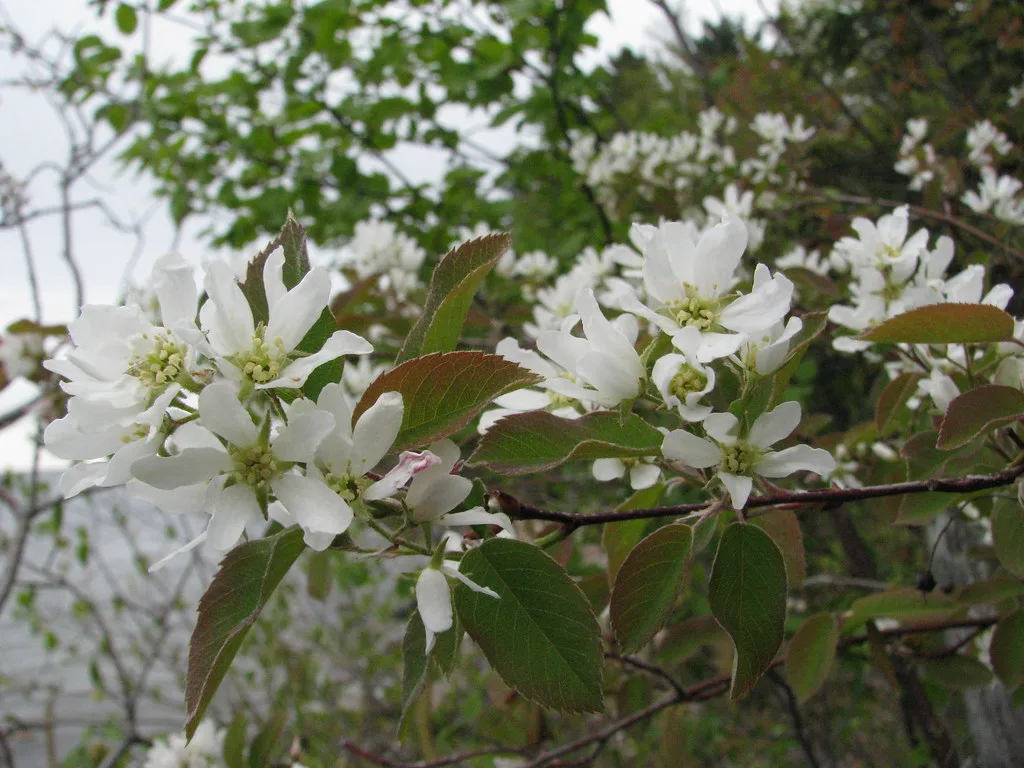
- Amelanchier canadensis – The Canadian Serviceberry
The Canadian Serviceberry, also known as Amelanchier canadensis, is a small tree that can grow up to 25 feet tall. It is native to eastern North America and produces white flowers in the spring and blue-black fruit in the summer. The fruit is sweet and can be eaten fresh or used for making jams and jellies. The Canadian Serviceberry prefers moist, well-drained soils and can tolerate both full sun and partial shade.
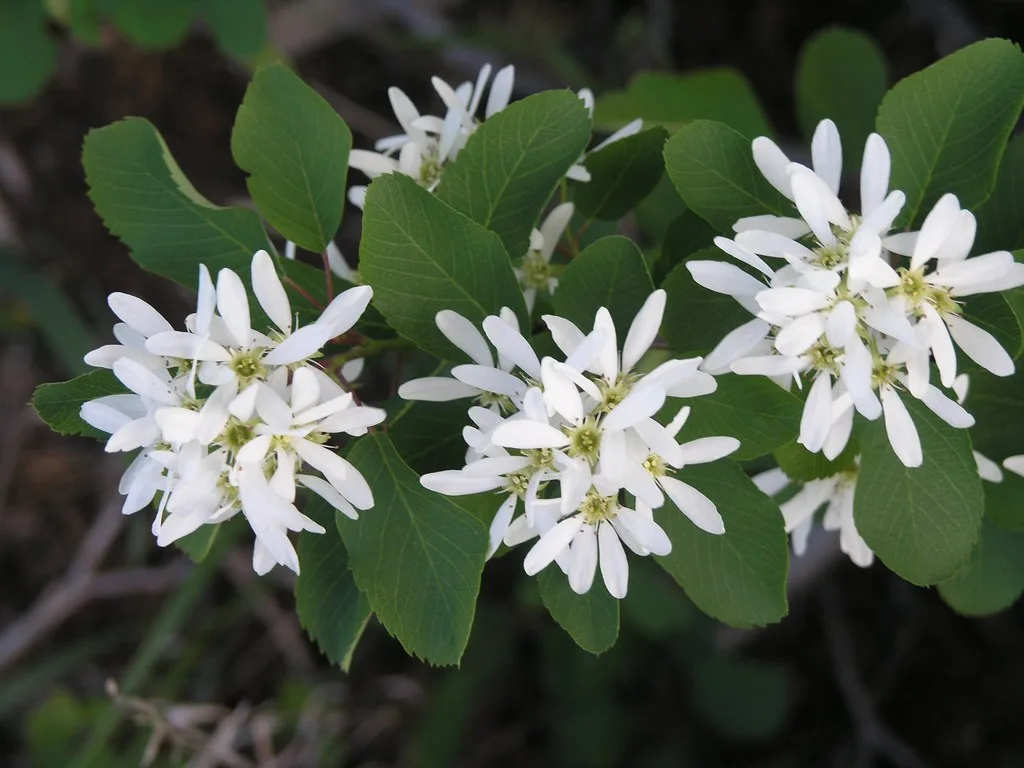
- Amelanchier laevis – The Smooth Serviceberry
The Smooth Serviceberry, also known as Amelanchier laevis, is a small tree that can grow up to 25 feet tall. It is native to eastern North America and produces white flowers in the spring and dark blue-black fruit in the summer. The fruit is sweet and can be eaten fresh or used for making jams and jellies. The Smooth Serviceberry prefers well-drained soils and can tolerate both full sun and partial shade.
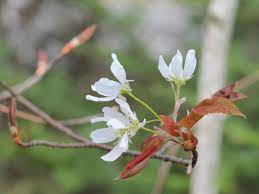
- Amelanchier stolonifera – The Running Serviceberry
The Running Serviceberry, also known as Amelanchier stolonifera, is a small tree that can grow up to 10 feet tall. It is native to eastern North America and produces white flowers in the spring and dark purple-black fruit in the summer. The fruit is sweet and can be eaten fresh or used for making jams and jellies. The Running Serviceberry prefers moist, well-drained soils and can tolerate both full sun and partial shade.
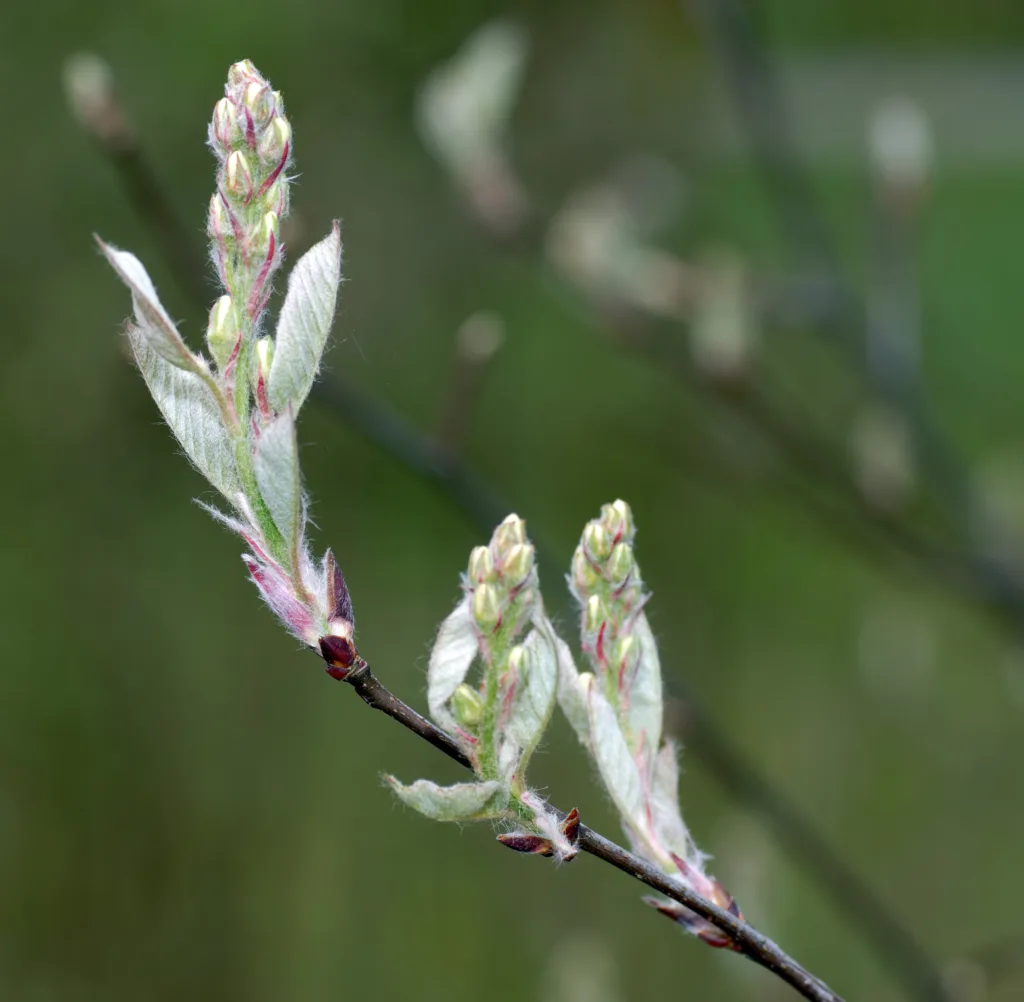
Benefits of Growing a Serviceberry Tree
If you’re looking for an ornamental tree that produces delicious fruit, then you should consider planting a serviceberry tree. Here are some benefits of growing a serviceberry tree:
- Edible Fruit: Serviceberries produce small, flavorful berries that are great for eating fresh, making jams and jellies, or baking into desserts. They are also high in antioxidants and other nutrients, making them a healthy addition to your diet.
- Beautiful Spring Flowers: Serviceberry trees are known for their beautiful white or pink flowers that bloom in the early spring. The flowers attract pollinators such as bees, butterflies, and hummingbirds, which can help your garden thrive.
- Attractive Fall Foliage: In the fall, serviceberry leaves turn shades of yellow, orange, and red, adding color and interest to your garden or landscape.
- Low Maintenance: Serviceberry trees are generally easy to care for and require little maintenance once established. They are also resistant to many common tree diseases and pests.
- Versatile Planting: Serviceberry trees can be planted in a variety of locations, including full sun or partial shade, and in a range of soil types. They are also suitable for both urban and rural environments.
- Habitat and Wildlife: Serviceberry trees provide valuable habitat and food for wildlife such as birds, squirrels, and other small mammals.
Overall, planting a serviceberry tree can provide many benefits, from its attractive spring flowers and fall foliage to its delicious fruit and low maintenance requirements. If you’re looking for a beautiful and functional addition to your garden, consider planting a serviceberry tree.
Also Read : Willow Tree: Everything You Need to Know About Growing, Care, and Uses
How to grow serviceberry tree in your garden
Planting a serviceberry tree is a straightforward process, but there are a few things to keep in mind to ensure its success. Here are some tips on how to plant serviceberry trees:
- Choose the Right Location: Serviceberry trees prefer full sun or partial shade and well-drained soil. They can tolerate a range of soil types but prefer moist, slightly acidic soil. Ensure that the planting location provides enough space for the tree to grow, as serviceberries can reach up to 25 feet tall and wide.
- Timing: Serviceberry trees should be planted in the spring or fall when the soil is moist and the temperatures are mild. Avoid planting during hot summer months or during periods of drought.
- Soil: Serviceberry trees are not particularly picky when it comes to soil, but they do prefer well-drained soil that is slightly acidic. They can grow in a variety of soil types, including sandy, loamy, or clay soil, but it’s important that the soil is not waterlogged or compacted, as this can cause root rot. Before planting a serviceberry tree, it’s a good idea to test the soil pH and make any necessary adjustments. A pH range of 5.5 to 6.5 is ideal for serviceberry trees. If the soil pH is too high, you can lower it by adding elemental sulfur or peat moss to the soil. If the pH is too low, you can raise it by adding lime to the soil. In addition to pH, it’s also important to ensure that the soil is well-drained. Serviceberry trees do not like to have their roots sitting in water, as this can cause root rot and other issues. If the soil in your planting location is heavy or clay-like, you can amend it by mixing in organic matter such as compost or aged manure. This will help to improve the soil structure and drainage, providing a healthy environment for your serviceberry tree to grow.
- Dig the Hole: Dig a hole that is twice the width of the root ball and the same depth as the root ball. Loosen the soil at the bottom of the hole and mix in some organic matter such as compost.
- Planting the Tree: Place the tree in the hole and ensure that it is level with the surrounding soil. Backfill the hole with soil and tamp it down gently to remove any air pockets.
- Watering: After planting, water the tree thoroughly and regularly to keep the soil moist. Once established, serviceberry trees only need to be watered during periods of drought.
- Pruning: Prune serviceberry trees during the dormant season to promote a healthy, well-shaped tree. Remove any dead, diseased, or crossing branches, and trim back any branches that are growing too close to each other.
- Fertilizing: Serviceberry trees do not require heavy fertilization, but a light application of a balanced fertilizer in the spring can promote healthy growth.
- Pest and Disease Control: Serviceberry trees are relatively resistant to pests and diseases, but they can be susceptible to common issues such as rust, leaf spot, and fire blight. Ensure that the tree is planted in a location with good air circulation and avoid overhead watering, which can promote fungal growth. If necessary, treat any pest or disease issues with an appropriate fungicide or insecticide.
- Harvesting: Serviceberries are ready to harvest in late spring or early summer, depending on the variety. The berries should be plump and dark purple when ripe. Harvest them by hand or with a berry picker, being careful not to damage the tree or the fruit.
By following these tips, you can successfully plant and care for a serviceberry tree, enjoying its beauty and delicious fruit for years to come.
Also Read: What is Pluto Time Calculator? Find Your Pluto Time
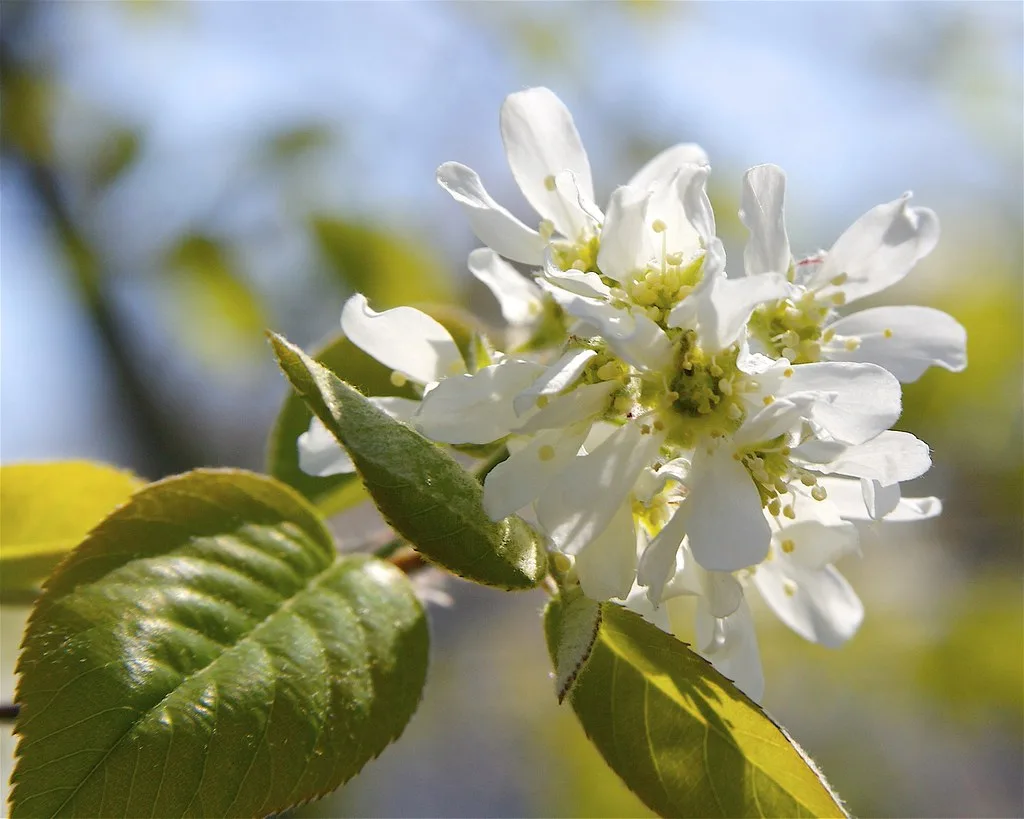
Where to Plant Serviceberry Tree
When choosing a location to plant your serviceberry tree, it’s important to consider a few key factors to ensure that it will thrive and grow to its full potential.
- Sunlight: Serviceberry trees prefer full sun to partial shade, meaning they require at least six hours of direct sunlight per day. Choose a location that receives ample sunlight throughout the day.
- Soil drainage: As previously mentioned, serviceberry trees prefer well-drained soil. Avoid planting them in areas that are prone to standing water or have poor drainage.
- Wind protection: Serviceberry trees have delicate branches that can be easily damaged by strong winds. Plant them in a location that is protected from strong winds, such as near a fence or building.
- Space: Serviceberry trees can grow up to 20 feet tall and 15 feet wide, so it’s important to choose a location that provides enough space for the tree to grow without being crowded or obstructed.
- Climate: Serviceberry trees are hardy in USDA Zones 2-9, which means they can tolerate a wide range of temperatures and climates. However, they do prefer cooler temperatures and can be damaged by hot, dry conditions.
How to Care for Serviceberry Tree
Caring for serviceberry trees is relatively easy, but it’s important to follow a few key maintenance tips to ensure that the tree stays healthy and produces an abundant harvest.
- Watering: Serviceberry trees prefer moist but well-drained soil, so it’s important to keep the soil consistently moist but not waterlogged. Water deeply once a week during dry periods, or more frequently during periods of extreme heat or drought.
- Pruning: Pruning serviceberry trees is important to encourage healthy growth and fruit production. Prune in late winter or early spring while the tree is dormant, removing any dead or diseased branches. Also, remove any branches that are crossing or rubbing against each other. Serviceberry trees have a natural tendency to produce suckers, which are new growth shoots that emerge from the base of the tree. Remove suckers as they appear to encourage healthy growth.
- Fertilizing: Serviceberry trees don’t require a lot of fertilization, but it can be beneficial to provide a slow-release fertilizer in early spring. Choose a balanced fertilizer with equal amounts of nitrogen, phosphorus, and potassium.
- Mulching: Mulching around the base of the tree can help retain moisture and suppress weeds. Apply a 2-3 inch layer of organic mulch such as wood chips or shredded bark, being careful not to mound the mulch up against the trunk of the tree.
- Pest and Disease Control: Serviceberry trees are relatively pest and disease resistant, but they can be susceptible to certain issues such as powdery mildew, fire blight, and borers. Monitor your tree regularly for signs of pests or disease, and take action promptly if you notice any issues. You can use natural remedies such as neem oil or insecticidal soap to control pests, and pruning and removing infected branches can help prevent the spread of disease.
Serviceberry Tree Pests and Diseases
Serviceberry trees are generally healthy and hardy plants, but they can be affected by a few common pests and diseases. Here are some of the most common issues and how to treat them:
- Cedar-Apple Rust: This fungal disease causes yellow spots on the leaves, followed by orange or brown spots with black dots on the undersides of the leaves. Infected leaves may eventually drop off the tree. To control cedar-apple rust, remove any nearby cedar trees and apply a fungicide to the serviceberry tree when the leaves begin to emerge in spring.
- Fire Blight: This bacterial disease causes new shoots and leaves to wilt and turn black, giving the appearance of a fire-damaged tree. To control fire blight, remove any infected branches promptly and dispose of them away from the tree. Avoid overhead watering and apply a copper fungicide in spring to prevent new infections.
- Powdery Mildew: This fungal disease causes a white powdery coating on the leaves and stems, which can lead to stunted growth and leaf drop. To control powdery mildew, improve air circulation around the tree, avoid overhead watering, and apply a fungicide as needed.
- Borers: These insects can cause damage to the trunk and branches of serviceberry trees, resulting in stunted growth, wilting, and eventual death. To control borers, use a sticky trap to monitor for their presence, and apply an insecticide if necessary.
- Japanese Beetles: These pests can defoliate serviceberry trees, causing significant damage. To control Japanese beetles, handpick them off the tree, or use a natural insecticide.
By being aware of these common pests and diseases and taking prompt action to control them, you can keep your serviceberry tree healthy and productive for many years. Regular monitoring and proper maintenance are key to keeping your tree free from these issues.
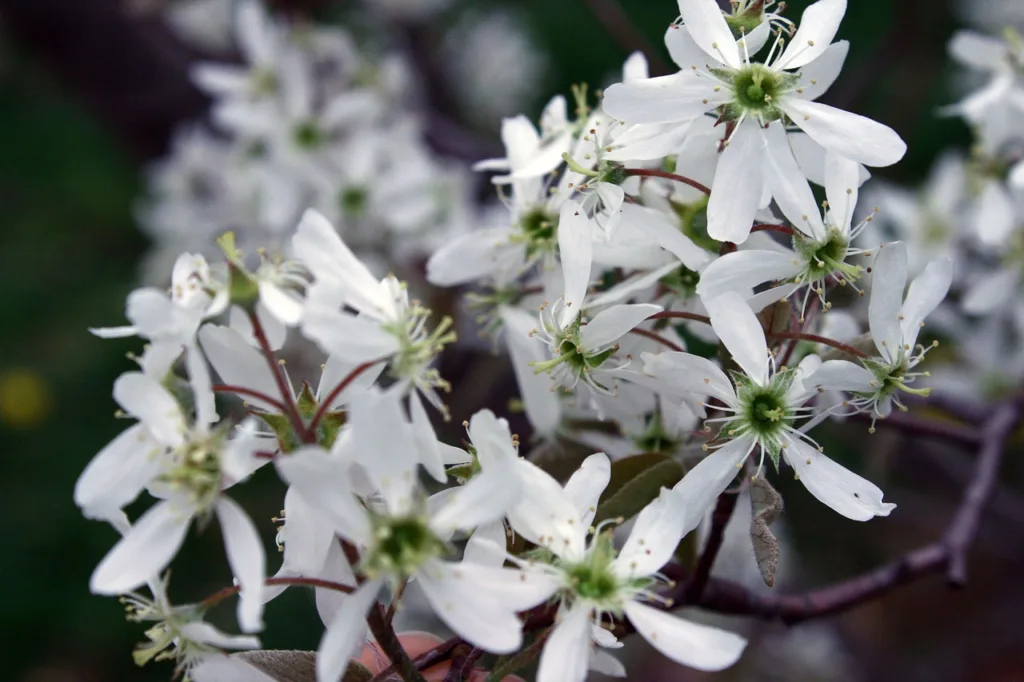
Serviceberry Tree Harvesting and Preservation
Harvesting and preserving the fruit of a serviceberry tree is an enjoyable and rewarding process. Here are some tips on when and how to harvest, store, and preserve the fruit:
- When to Harvest: Serviceberries are ready to be harvested when they are deep purple in color and slightly soft to the touch. The fruit should come off easily when gently pulled.
- How to Harvest: To avoid damaging the fruit, use a gentle touch when harvesting serviceberries. Use your fingers to gently pluck the fruit from the stem, or use a small pair of scissors or pruning shears to snip the stem just above the fruit.
- Storing Fresh Fruit: Serviceberries can be stored in the refrigerator for up to one week in a sealed container. To freeze the fruit, spread them in a single layer on a baking sheet and freeze for a few hours. Once the fruit is frozen, transfer it to an airtight container or freezer bag and store in the freezer for up to six months.
- Preserving the Fruit: Serviceberries are perfect for making jams, jellies, and pies. To make jam or jelly, combine the berries with sugar and lemon juice, and cook until thickened. To make a pie, mix the berries with sugar and cornstarch, and bake in a pie crust. Serviceberries can also be dried in a dehydrator and stored for later use in granola or trail mix.
Serviceberry Tree Culinary Uses
Serviceberries are a versatile fruit that can be used in a variety of culinary applications. Here are some delicious recipes and ideas for using the fruit:
- Serviceberry Muffins: Add fresh or frozen serviceberries to your favorite muffin recipe for a delicious and nutritious breakfast treat.
- Serviceberry Jam: Make a sweet and tangy jam by combining serviceberries, sugar, and lemon juice. Serve with toast or use as a topping for pancakes or waffles.
- Serviceberry Pie: Mix fresh or frozen serviceberries with sugar, cornstarch, and a splash of lemon juice, and bake in a pie crust for a classic dessert.
- Serviceberry Sauce: Combine serviceberries with sugar, water, and a dash of cinnamon for a flavorful sauce that can be used as a topping for ice cream, pancakes, or oatmeal.
- Serviceberry Smoothie: Blend fresh or frozen serviceberries with yogurt, milk, and honey for a refreshing and healthy smoothie.
- Serviceberry Syrup: Combine serviceberries with sugar and water, and simmer until thickened. Serve over pancakes, waffles, or French toast.
- Serviceberry Salad Dressing: Puree serviceberries with olive oil, balsamic vinegar, and honey for a unique and flavorful salad dressing.
These are just a few ideas for using serviceberries in your cooking and baking. With their sweet-tart flavor and high nutritional content, serviceberries are a delicious and healthy addition to any meal.
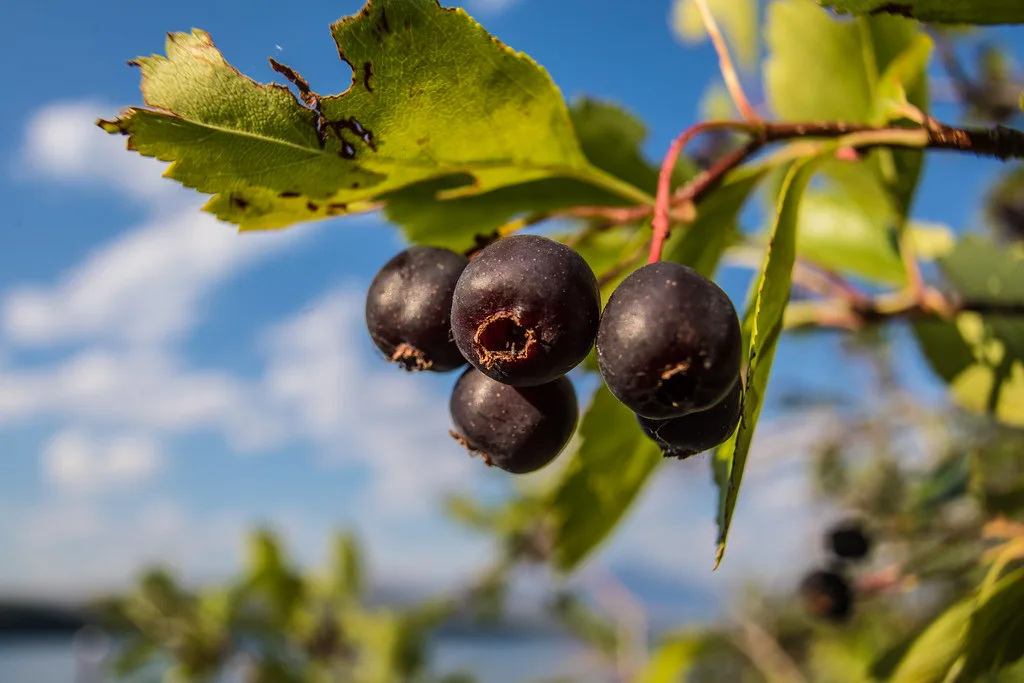
Serviceberry Tree Landscaping
Serviceberry trees are not only beautiful and productive, but they also have a great potential for landscaping. Here are some tips on how to incorporate serviceberry trees into your garden or landscape design:
- Placement: Serviceberry trees can be used as ornamental specimens, natural screens, or as part of a mixed border. Place them in a location that receives full sun to partial shade, with well-drained soil.
- Companion Planting: Serviceberry trees work well when planted with other native shrubs and flowers, such as red twig dogwood, spirea, and bee balm. This not only adds to the visual appeal but also creates a natural habitat for wildlife.
- Seasonal Interest: Serviceberry trees provide interest throughout the seasons. In the spring, they produce delicate white or pink blossoms that attract pollinators. In the summer, their foliage provides shade and a lush backdrop for other plants. In the fall, their leaves turn a brilliant red or orange, adding to the autumn colors.
- Maintenance: Serviceberry trees require regular pruning to maintain their shape and size. Prune in the late winter or early spring to remove dead or diseased branches, and to promote new growth.
- Edible Landscaping: Serviceberry trees are not just beautiful but also productive. They produce delicious fruit that can be used in many culinary applications. Planting serviceberry trees in your landscape can provide you with a fresh supply of fruit for years to come.
By incorporating serviceberry trees into your landscape, you not only add beauty but also provide habitat for wildlife and a source of fresh, nutritious fruit.
Serviceberry Tree: Frequently Asked Questions (FAQs)
What is a serviceberry tree?
A serviceberry tree is a deciduous tree that is native to North America. It produces small, edible fruit in early summer and is a popular ornamental tree for landscaping.
How big do serviceberry trees grow?
Serviceberry trees can vary in size depending on the species and growing conditions. Most varieties grow to be 15-30 feet tall with a similar spread.
When do serviceberry trees bloom?
Serviceberry trees typically bloom in early spring, producing delicate white or pink flowers.
How often should I water my serviceberry tree?
Serviceberry trees should be pruned in late winter or early spring before they begin to bloom. Prune out any dead, diseased, or damaged branches, and thin out any crossing branches to promote air circulation.
What pests and diseases affect serviceberry trees?
Serviceberry trees can be susceptible to a few pests and diseases, including cedar-apple rust, powdery mildew, and fire blight. Regular maintenance, such as proper pruning and good air circulation, can help prevent these issues.
When is the best time to harvest serviceberries?
Serviceberries should be harvested when they are fully ripe and have a deep, purplish-black color. This usually occurs in early summer, around June or July.
What can I do with serviceberries?
Serviceberries are delicious eaten fresh or can be used in many culinary applications, such as jams, pies, and muffins. They can also be dried or frozen for later use.
How do I incorporate serviceberry trees into my landscape?
Serviceberry trees make great ornamental trees and can be used as a natural screen or as part of a mixed border. They also attract pollinators and provide habitat for wildlife. Plant them in a location that receives full sun to partial shade and well-drained soil.


